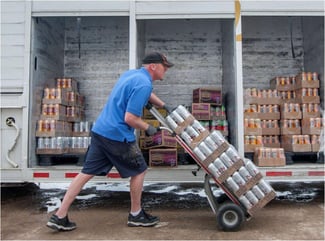The average profit margin for restaurants is approximately 3-5%. When you’re working on such a small margin, attention to detail is crucial. Even tiny amounts of shrinkage or minor errors in your processes can have a significant impact on your profitability.
There are so many opportunities for waste, which makes it important to do everything possible to optimize all parts of your business. This is the only way to ensure you maintain a profit margin that is sustainable.
One place where many bars can improve is in the way they check in their deliveries. The following steps will help you avoid losing money from the ordering and delivery process.
1. Establish Reasonable Ordering Guidelines
 It’s a lot more fun to purchase new products and create interesting drinks with these ingredients than it is to monitor and manage your inventory effectively. As a result, many bars fail to focus enough energy on this aspect of the process. In order to ensure your ordering reflects what you actually need, you must establish clear ordering guidelines.
It’s a lot more fun to purchase new products and create interesting drinks with these ingredients than it is to monitor and manage your inventory effectively. As a result, many bars fail to focus enough energy on this aspect of the process. In order to ensure your ordering reflects what you actually need, you must establish clear ordering guidelines.
The following tips will help you optimize your ordering process:
- Carry a reasonable number of products – The average bar carries about 200 products. That being said, the right number for you will depend on your bar’s unique business model. If you carry too many items, it will unnecessarily complicate your operations. We recommend setting a limit on the number of items you carry so your bar manager doesn't fall victim to the usual product selection creep.
- Maintain a reasonable ratio between inventory on-hand and product used per week – Bars should shoot to keep this ratio at or below 4:1. In other words, you should never have more than four times the amount of product on-hand that you sell on a weekly basis. If your weekly sales are $20,000 and your liquor cost is 20%, you are spending $4,000 on product each week. In this scenario, you should never have more than $16,000 of inventory on-hand at any time.
2. Develop a System for Ordering Based on Data and Pars, Not Shelf Space
Many bars approach ordering as a way to ensure they don’t run out of product. This usually leads to over-ordering. You need a system that objectively tells you how much product you actually need to order. There are two ways to approach this that will ensure you don’t carry too much inventory on-hand:
- Manual pars – You determine the pars that trigger a new order of that product
- Automated pars – You can use an intelligent system that will calculate your pars for you based on your usage
Many sophisticated bar inventory systems will provide this automated par service for you, ensuring you are only ordering precisely what you need.
3. Make Your Order List Available to Your Staff
After you’ve placed an order, make sure your order list is easily accessible by any staff members responsible for receiving deliveries. Many bars lose a lot of money by paying for products they didn’t order. By having this order list readily available when deliveries arrive, you can ensure every item delivered was actually ordered. If you find an item that wasn’t on the list, send it back.
4. Ensure Deliveries Aren’t Merged with Existing Product
 Communicate with delivery drivers and make sure they don’t place new deliveries in the same location as your existing product. Otherwise, it will be impossible to check in new deliveries because you won’t know what was just delivered and what was previously there.
Communicate with delivery drivers and make sure they don’t place new deliveries in the same location as your existing product. Otherwise, it will be impossible to check in new deliveries because you won’t know what was just delivered and what was previously there.
5. Check the Invoice Twice
When checking in deliveries, we always recommend checking the invoice twice:
- Check what is actually there versus what is listed on the invoice to make sure you’re only paying for what was delivered.
- Check what is actually there versus what was ordered. If you see an unusual new product in the delivery, make sure it is supposed to be there. If you didn’t order it, refuse the product.
6. Mark All Invoices When They’re Checked In
Make sure your staff always puts a physical mark on each line once they’ve checked the item in. Once they’ve checked in the entire invoice, have them put their name at the bottom. This creates an additional layer of accountability. You will always know who checked in each delivery, and you can ask that person directly if you notice any discrepancies.
7. Monitor and Refine Against Your Guidelines
When you’re doing your weekly bar inventory audits, compare the total value of inventory on-hand to the total value of inventory used (total sales x liquor cost). This will allow you to make sure your inventory on-hand stays within a 4:1 ratio.
If you’d like to learn more about how Bar-i can streamline your operations and help you maximize profits, please contact us today to schedule a free consultation. We serve bars and restaurants nationwide from our offices in Denver, Colorado.


-1.png)